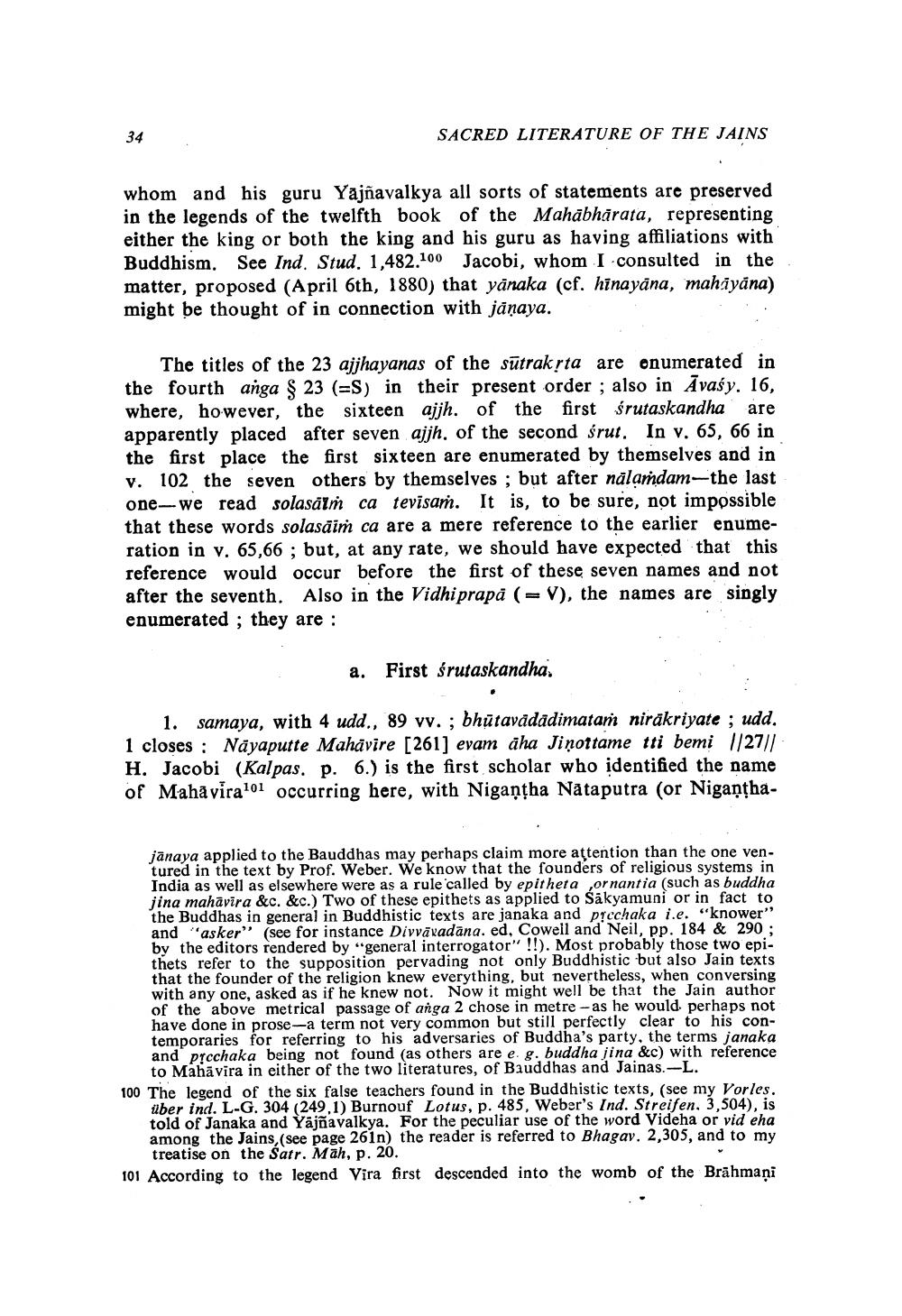________________
34
SACRED LITERATURE OF THE JAINS
whom and his guru Yajñavalkya all sorts of statements are preserved in the legends of the twelfth book of the Mahabharata, representing either the king or both the king and his guru as having affiliations with Buddhism. See Ind. Stud. 1,482.100 Jacobi, whom I consulted in the matter, proposed (April 6th, 1880) that yānaka (cf. hinayāna, mahīyāna) might be thought of in connection with jāņaya.
The titles of the 23 ajjhayanas of the sūtrakrta are onumerated in the fourth anga § 23 (=S) in their present order ; also in Āvašy. 16, where, however, the sixteen ajjh. of the first śrutaskandha are apparently placed after seven ajjh, of the second śrut. In v. 65, 66 in the first place the first sixteen are enumerated by themselves and in v. 102 the seven others by themselves ; but after nälamdam-the last one-- we read solasalṁ ca tevisaṁ. It is, to be sure, not impossible that these words solasaiṁ ca are a mere reference to the earlier enumeration in v. 65,66 ; but, at any rate, we should have expected that this reference would occur before the first of these seven names and not after the seventh. Also in the Vidhi prapå (=V), the names are singly enumerated ; they are :
a. First śrutaskandha.
1. samaya, with 4 udd., 89 vv. ; bhūtavādādimataṁ niräkriyate ; udd. 1 closes : Nayaputte Mahavire [261] evam äha Jiņottametti bemi 1/27// H. Jacobi (Kalpas. p. 6.) is the first scholar who identified the name of Mahāvira101 occurring here, with Nigaņţha Nataputra (or Nigantha
janaya applied to the Bauddhas may perhaps claim more attention than the one ventured in the text by Prof. Weber. We know that the founders of religious systems in India as well as elsewhere were as a rule called by epitheta ,or nantia (such as buddha jina mahāvira &c. &c.) Two of these epithets as applied to Säkyamuni or in fact to the Buddhas in general in Buddhistic texts are janaka and prcchaka i.e. "knower" and asker” (see for instance Divvāvadāna. ed, Cowell and Neil, pp. 184 & 290 ; by the editors rendered by “general interrogator" !!). Most probably those two epi. thets refer to the supposition pervading not only Buddhistic but also Jain texts that the founder of the religion knew everything, but nevertheless, when conversing with any one, asked as if he knew not. Now it might well be that the Jain author of the above metrical passage of anga 2 chose in metre-as he would perhaps not have done in prose-a term not very common but still perfectly clear to his contemporaries for referring to his adversaries of Buddha's party, the terms janaka and prcchaka being not found as others are e. g. buddha jina &c) with reference
to Mahāvira in either of the two literatures, of Bauddhas and Jainas.-L. 100 The legend of the six false teachers found in the Buddhistic texts, (see my Vorles.
über ind. L-G. 304 (249,1) Burnouf Lotus, p. 485, Weber's Ind. Streifen, 3,504), is told of Janaka and Yajñavalkya. For the peculiar use of the word Videha or vid eha among the Jains,(see page 261n) the reader is referred to Bhagav, 2,305, and to my
treatise on the Satr. Mah, p. 20. 101 According to the legend Vira first descended into the womb of the Brāhmani




